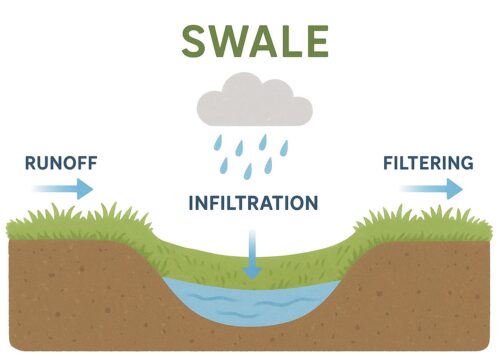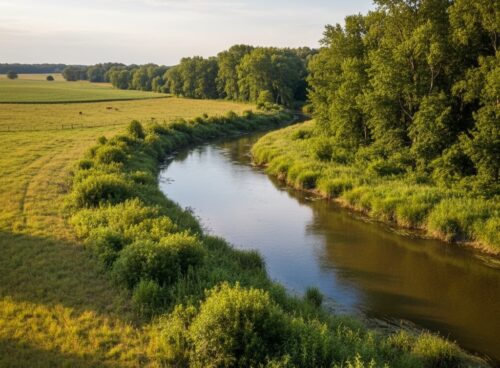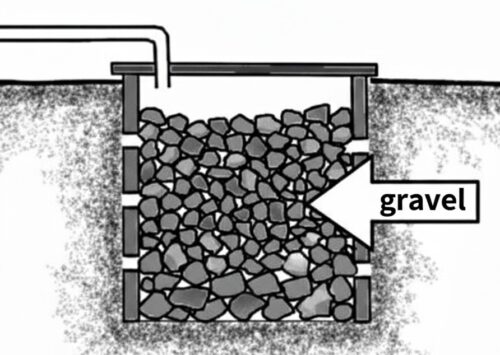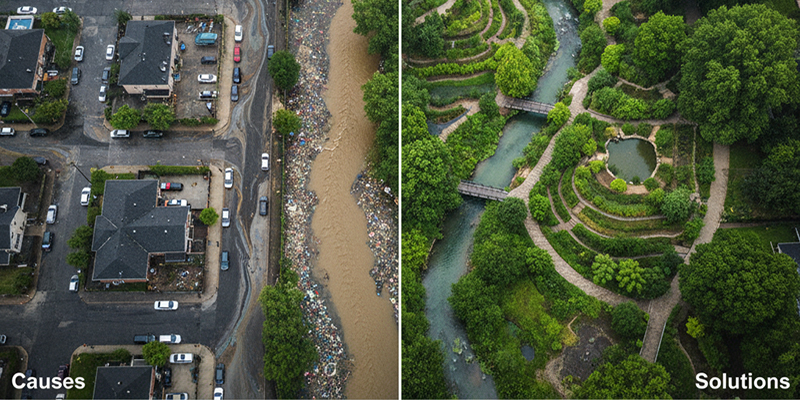Runoff pollution happens all over the world, including in Australia, but it is more reported in Mediterranean, Asian, and North American cities. These areas are usually populated (like China, India, and Indonesia) and are famous for their intense agricultural and industrial activities. In Australia, urban expansion, mining, and agricultural practices also contribute to stormwater contamination. Runoff pollution can be reduced through effective land management and erosion control; however, achieving this requires detailed planning and the use of advanced technologies. In the following article, we discuss the causes, prevention methods, and environmental impacts of stormwater pollution.
What Is Runoff Pollution?
When it rains or snows, the water doesn’t always penetrate the ground. Instead, it sometimes flows over sidewalks, parking lots, yards, and fields. This flowing water is called runoff (or stormwater runoff) and usually occurs when the rain or snow is heavy.
As the water moves across the lands and streets, it picks up anything it touches, such as soil, leaves, oil from driveways, fertiliser from lawns, animal waste, plastics, cigarette butts, pesticides, etc. Then, it enters storm drains or goes directly into streams, rivers, lakes, and seas, without being treated. Since this water contains all kinds of pollutants, it is called runoff pollution.
What Causes Runoff Pollution?
To be honest, the main cause of runoff pollution is human agricultural, industrial, and urban activities. When we park our cars in the driveway or build a small cottage in the foothills, runoff is not the result we are hoping for, but we cause it anyway.
Here are the main 4 causes of stormwater runoff pollution:
- Impervious surfaces: Things like roads, sidewalks, driveways, and rooftops don’t allow water to sink into the ground, so the water runs off and destroys everything on its way. Also, these hard and impermeable surfaces increase the water’s speed and force, leading to drainage systems failing.
- Land‐use change: Replacing forests or meadows with buildings and pavements is one of the major causes of stormwater runoff. The canopies and roots of trees prevent floods, while concrete and asphalt block water from penetrating the soil.
- Uncontrolled soil erosion: When soil is left bare (for example, at construction sites, farmland, or areas where vegetation has been removed), it becomes loose and is easily washed away by rain. This water contains heavy sediments and chemicals, so it can clog the drains, bury fish eggs, and kill aquatic animals.
- Low-absorptive soil: Some soil types, like clay, have lower permeability and absorb water slowly. In other words, the water goes down more slowly and runs on the surface.
Runoff Pollution Effects on the Environment?
Runoff pollution can hurt both nature and people in many ways. It carries nutrients (like nitrogen, phosphorus), sediment (soil particles), toxic chemicals (oil, heavy metals, pesticides), bacteria, parasites, and viruses. Such pollutants:
- Increase algae growth speed. Some of these algae are toxic to humans and animals.
- Make the lakes and streams’ water unsafe for drinking, swimming, and fishing.
- Make the water cloudy and block the sunlight needed for photosynthesis.
- Clog water treatment systems.
- Enter the food chain through seafood.
- Can choke and kill aquatic animals.
- Increase flood risk.
- Make the beaches unsafe for hatching.
- Affect the underground water level.
Also read: Algae Wastewater Treatment for Cleaner Waterways
How to Prevent Stormwater Runoff?
Preventing stormwater pollution is very hard, as a large number of organisations and sectors are involved. Homeowners, businesses, engineers, and local governments must cooperate to stop runoff pollutants from entering the streams, seas, and groundwater. Many nations use the following techniques to overcome such problems:
- Using less (or no) chemical fertilisers and pesticides on lawns and gardens. If such chemicals are required, they should at least not be used during the rainy seasons.
- Fixing oil leaks, recycling used oil and fluids, and washing cars at a car wash (not in the yard or in the street).
- Planting native plants, reducing bare soil, and keeping vegetation around streams alive.
- Creating rain gardens, soakaways (filled with rubble or plastic), and permeable pavements. These systems let the water slowly penetrate the soil instead of running on the surface.
- Cleaning storm drains regularly, especially during fall and spring. It prevents large debris and pollutants from clogging drains.
- Using sediment traps on construction sites.
- Lowering land use changes as much as possible.
Note: Educating people about how their everyday choices affect runoff plays an important role in preventing it. Families, schools, and governments must work together to prepare the next generation for dealing with stormwater pollution.
Stormwater Runoff Solutions
In this section, we have explained the best and most common strategies to manage runoff pollution:
Low Impact Development (LID)
In simple terms, LID refers to using “natural elements” to manage stormwater runoff. This includes rain gardens, green roofs, swales, permeable pavements, tree canopy, and infiltration trenches.

Detention and retention basins
Both detention and retention basins are man-made ponds that help manage runoffs. A detention basin is dry between rainfalls, but it can temporarily hold water and release it at a controlled rate. A retention basin (or wet pond) has water throughout the year and removes sediment, nutrients, and pollutants naturally. The wet ponds are also perfect habitats for insects, amphibians, fish, birds, and plants that grow in and around them.
Bioretention systems
A bioretention system is a shallow, landscaped rain garden that uses soil and plants to naturally filter and clean stormwater runoff from places like roofs and parking lots.

Permeable or porous pavement
Unlike ordinary pavements, porous pavements are made of open-pore concrete and asphalt, so the water can soak through into the ground. The stone layer in such pavements acts as a natural filter that removes large solids from the water before it penetrates the soil.
Riparian buffers
A riparian buffer refers to a vegetated area along a river, stream, or lake. These buffers filter sediment, slow down the runoff to prevent flooding, and stabilise banks from erosion. They are also a rich habitat for aquatic creatures and keep the water cool for them.

Stormwater management devices
In some places, specially designed filters or separators are installed to treat runoff before it enters the streams or groundwater. Cartridge filters, underground pits filled with gravel, perforated pipes, and gravel-filled trenches are some examples of these devices that filter stormwater runoff.

A Quick Review
Stormwater runoff pollution can be a hazard to the environment if not managed properly. It carries viruses, bacteria, parasites, heavy metals, and other harmful substances that can destroy aquatic life or put human lives in danger. Fortunately, stormwater pollution can both be prevented and resolved if people and governments work together. There are also special companies that work exclusively on treating water and protecting aquatic life. AquipTech (AIMEQUIP) is an Australian company working specifically in this field. With its advanced technologies and up-to-date knowledge, the company treats water before it gets back to the environment or the urban water cycle.
Also Read: Stormwater Treatment in Australia: Protecting Waterways, Infrastructure, and Communities
FAQs
- What are the 5 main factors that affect runoff?
Size, shape, slope, land use, and soil characteristics like infiltration capacity and moisture affect how quickly the rainfall becomes runoff.
- What are the most common pollutants that the runoff moves?
Cars’ oil and antifreeze, fertilisers and lawn pesticides, animal waste, and construction litter are the most common pollutants moved by runoff.
- Why is runoff left untreated sometimes?
When vegetation is removed and the soil is compacted (by tilting and ploughing), the runoff is greater and faster. In such times, the water cannot be filtered naturally.
- What is the effect of fertiliser runoff?
Runoff fertilisers cause an algae bloom, kill aquatic organisms, and increase nitrates in drinking water.

